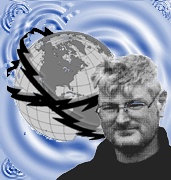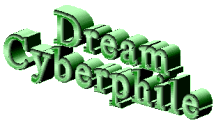| Wilkerson, Richard Catlett (2000 Spring). Dreaming and Creativity
Online. Dream Time Cyberphile. Dream Time 17(2).
The Dream Cyberphile by Richard Catlett Wilkerson Dreaming and Creativity Online In this issue, the Cyberphile will explore how dream inspired art is emerging in the Digital Age. A review of online art galleries as well as new techniques for computer generated graphics will be offered. The Online Art Galleries In a past issue [Dream Time 14(3) Summer 1997] the Cyberphile explored
some of the dream inspired art galleries that are now online. Here I would
like to mention a few of the new galleries and update you on the some of
the older ones. However, I highly recommend to those interested in dream
inspired galleries to connect with the original article online and explore
the wide variety of cyber-dream art venues. These galleries offer the dream inspired artist a chance to exhibit his/her work for a world wide audience. Joanne Rochon's art, for example, was displayed on the ASD website gallery and this led to a commission to design art for an NBC primetime show, Dream Walker. Those artists who would like feedback but feel shy about displaying images and deeply personal images can build anonymous galleries and have comments sent to anonymous e-mail addresses. A simple but elegant example is "Dreams: Artwork of the Collective
Unconscious", a graduate project by Gail Bixler?Thomas. Gail allows
dreamers to submit dreams as well as graphic art related to the dream and
shows these on mini-web galleries within her overall project themes, such
as insight, isolation or treasures. One of the largest private collections of dream inspired art online is
the shared gallery of Kathleen Eiswald and David Wells. These complex
photocollages give us a view of how newer computer graphics programs can
be used to express complex dream imagery. These artists have also developed covers for the Electric Dreams e-zine: One of the most well developed multi-media sites on dream inspired art
is the Epic Dewfall "Man Against Eternity" show. Epic enters his
lucid dreams and looks for pictures to paint, then returns to waking life
and reproduces these in various media. They are then digitalized and are
available online with related poetry at: In a recent project, Dewfall added 3-D gallery. This is sort of like a
movie where you can tell the movie camera to go wherever you want. When
you find the picture in the gallery that interest you, you can move closer
and then see the picture on the full screen. At other times, you might
just happen to direct your computer screen to look-up while in the
gallery, and see the night sky and moon. This kind of virtual movement is
the model of how we will be traveling along many of our paths in the
future and gives us a glimpse at some up-coming techniques of being able
to quickly and easily create movies of our dreams. If you don't have the required program installed on your computer, the
interactive gallery will not work. But to peek at some stills of the
gallery, see Henry Reed's dream inspired art project has extended over his life
time. Early dream doodles as a child began taking on stronger forms and
colors while was teaching at Princeton. By the time he had moved to
Virginia Beach, he was boldly experimenting with water colors and had
begun organizing the Dream Art Festivals. This art has now reached
Cyberspace and has become the Henry Reed Art Gallery. Jana Hutcheson has used the Internet to create a site where her dream
inspired music and painting has been transformed into digital format and
is available to everyone online. The visitor to "The Opposites, A
Journey of the Soul" site can look at a painting while listening to a
song created for it at the same time. Resources on dream inspired arts and books are available at the
DreamTree
One of the ways I used to create dream inspired collages was to cut out pictures in magazines. Now I can go online, find a graphic-search engine and type in the name of the picture I want. This produces a full selection of images to choose from. Note that these picture collages are for my personal expression and notebooks. If you plan to cut pieces from other people's pictures on the Web or in a magazine and use them publicly, be sure to secure the release from the owner. There is always the question that arises whether one kind of selection
process is better for bringing out dream images than another. As I go
through a magazine with the dream in mind, other pictures I wasn't really
looking for jump the foreground. There is something important and
unexpected that takes place during the selection process. But there is no
need to privilege paper pictures over other media. Selection always
involves some technologically mediated device, such as my scissors, my
glue. And to get right down to it, my eyes and hands are technological
extensions. What is lost searching in one manner may bring recovered in
another. Search engines for images: These images can be saved in a folder on your computer for later use
directly from your Web browser, or you may name your folders according to
the name of your dreams and keep adding pictures over time. I have a
grab-bag folder especially for dream graphics and then create a special
folder/directory when I want to work on one specific dream. In the dream
collage "The Encampment" I found some of the pictures I wanted
right away in my grab-bag folder and some I found online before beginning
to assemble the collage. I later went online to find picture-stills from
the movie "The English Patient" to complete the picture. I then
sent the dream and picture to Gail Bixler-Thomas who added it to her
online Dream Project: If you have a scanner, or any kind of digital cam-corder or digital camera, you can combine pictures online with those in books and magazines, or pictures of yourself. If you don't have a digital camera or scanner, you can take a pile of pictures down to your local copy center and very inexpensively put them on a disk that your computer graphic program can read. All of these pictures can come together in a computer graphics program that works with raster files. Some of these, like Paint Shop Pro, are very inexpensive, while others like Photoshop can be very expensive. What I especially like about these raster graphics programs is that I can change the collage even after its done. What I would like in the near future is a program that doesn't wait for me to type in the search word "horse" and "house" but automatically finds these after I finish typing my dream into a text editor. While I can stay close to the feeling of the dream, the computer can be building up a set of pictures I can select from. A little further in the future, I want a program that creates a little movie out of the dream text. One of the ways I like to work with my dreams is to draw and re-draw the dream. I originally began doing this after learning how Jungians would have clients wind, weave and loop back and around an image. This impeaching (poetic interweaving) is part of the group of notions that include the wandering in the labyrinth, the interlacing in illuminated manuscripts and non-directional approaches to understanding and exploration of dreams and other phenomena. In this process the original dream or concern is held in mind, feeling and body while the dreamer walks around, wanders, and creates a walk-about experience-container that allows the image to express itself in its own time. But limiting myself to a pencil often misses the more Baroque parts of
imagistic expression Jill Mellick, Arnold Mindell, and others have picked up on Jung's notion that the more modalities of expression we can use, the more channels we engage and the higher the chance of integration of unconscious processes. The importance of picking a media in which you *aren't* competent with is the simplest approach. Computer graphics programs offer just the thing for most of us who went to art classes where charcoal and paper were the main media. Adding other channels such as movement and voice becomes that much easier. I can dance my dream and record this, and add sounds which will play when parts of the art piece are selected. It will still be awhile before the other senses like smell and touch can be easily expressed over computer mediated communications. However, programs like Robert Bosnak's www.cyberdreamwork.com can give us hints to where this digital interface is leading. In his dreamwork online, Bosnak has participants connected to GSR machines that register the dreamer's emotional reactions and moods. While the graphs at this time only create a chart over time, its not
hard to imagine that colors and shapes could be assigned to the machines
and we could then watch our dreams as we tell them. Or better yet, we can
wake up and have a recording of the dream ready to play-back when the
alarm goes off. This article may be slightly altered from its original form on the ASD Newsletter to conform to Web Format.
|


 Return to ASD HOMEPAGE
Return to ASD HOMEPAGE